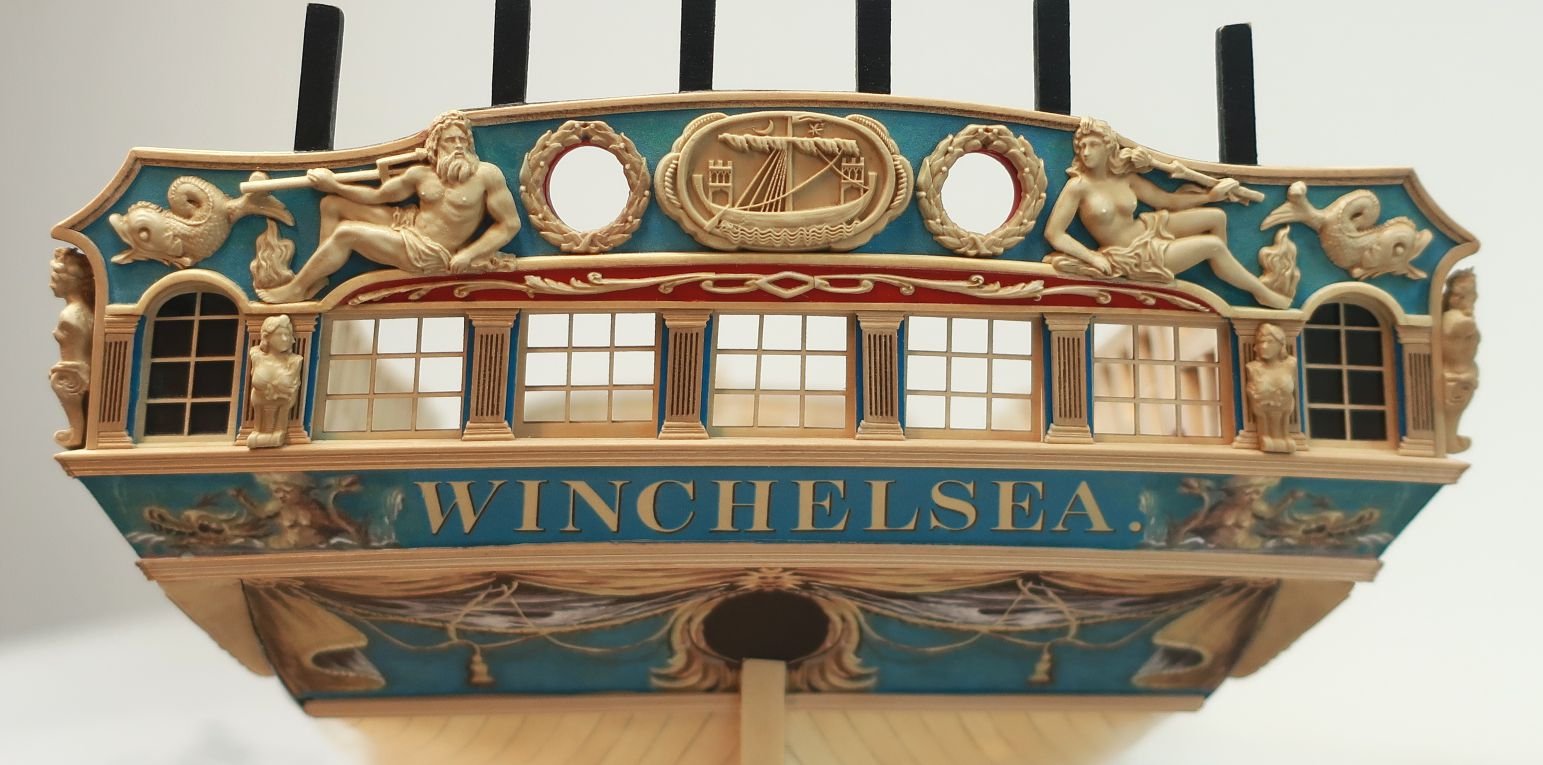-
Posts
9,101 -
Joined
-
Last visited
Reputation Activity
-
 Chuck got a reaction from WackoWolf in HMS Pegasus 1776 by Trussben - 1:48 - Swan-class sloop based on TFFM
Chuck got a reaction from WackoWolf in HMS Pegasus 1776 by Trussben - 1:48 - Swan-class sloop based on TFFM
Great looking project Ben. I will be following along with much interest and so far you are doing a fantastic job of it!!!
-
 Chuck reacted to augie in USF Confederacy by Augie & Moonbug - FINISHED - Model Shipways - 1:64
Chuck reacted to augie in USF Confederacy by Augie & Moonbug - FINISHED - Model Shipways - 1:64
Firstoff, a HAPPY NEW YEAR to everyone on MSW. May health, wealth and good building be in store for all!
Thought I'd start the year with a small update.
The planking of the upper hull has been completed with the addition of the second layers for the main and channel wales. In addition, the main wales have been painted........8 coats of diluted MS acrylic black. It's got the slightest bit of sheen to it but I'll address that later:
Here's a close up. The strake just above the black main wale is the 'black strake' which, for some reason, is not black. It is thinner than the wale so it makes for a nice detail. The wales and black strake have been tapered and contoured into one another so the edge is nice and neat. Thanks to Bob (Rafine) for mentioning the fact that he paints the edges of the wales before putting them on. That really simplifies the painting:
The next step will be treenailing the outer hull. I'll be using the 'drill and fill' technique. I need to get the right color on the filler and determine the pattern before proceeding. Once that's done a second coat of stain will be applied to darken the upper hull....then more painting etc. FUN STUFF
OK, let's see your latest !!!!!
-
 Chuck reacted to rlb in US Brig Oneida 1809 by rlb - The Lumberyard - 1:48 scale - POF - Lake Ontario Warship
Chuck reacted to rlb in US Brig Oneida 1809 by rlb - The Lumberyard - 1:48 scale - POF - Lake Ontario Warship
Thanks, Russ, Keith, and the Likes.
Keith, regarding your question, the short answer is: I don't know.
Long answer: I'm still confused on the nomenclature of all these boats (barge, launch, pinnace, longboat, cutter, deal cutter, gig, jollyboat, shallop, yawl, wherry). If I took some more time on research I might be able to learn more, but I've concentrated on just finding a suitable "cutter" to pattern mine on, and running with it. Even under the generic name cutter, I've seen some with gratings for the platform, some with "solid" platforms, some with spaced boards. With the forward platform, there are also many variations in configuration.
Now, here is a collection of ship's boats that puts my clumsy (in comparison) work to shame:
These are the boats for the 74 gun ship Rivoli, modeled by Doctor Michael. (and Keith, I'm pretty sure that's ebony ). Link to the source of the picture- http://forum.modelsworld.ru/topic8019.html where you can see more photos of the boats, and the whole stunning ship.
My cutter will end up looking (in configuration only!) most like the middle one in the row of five, and the second one in on the left, which looks about the same, just bigger. Those two appear to have a similar hull shape to mine, though my boat is smaller, and my oars will be single banked instead of double banked. Mine will also be stepped for one mast instead of two.
One point I saw interesting--these all have posts under the thwarts, which I'm not used to seeing. Maybe being double banked (with two crew per thwart) the posts were necessary, but on smaller single banked boats they were not?
Ron
-
 Chuck reacted to Mike Y in 21ft English Pinnace by Mike Y - FINISHED - Model Shipways - 1:24
Chuck reacted to Mike Y in 21ft English Pinnace by Mike Y - FINISHED - Model Shipways - 1:24
First of all, such nice boat requires a solid, but light dock. I don't have a dedicated space for modelling, so I share the table with my kid, and need to quickly rollout all my stuff and then hide it back:
Tapered the false keel, and also a bit tapered the real keel (just for a sake of beauty):
-
 Chuck got a reaction from Matrim in Why do some scale rope unravel and others don't
Chuck got a reaction from Matrim in Why do some scale rope unravel and others don't
The plastic stuff in kits is treated and thats why it wont unravel. Same is true for the natural stuff. But not all laid rope will unravel. If properly hardened after laying it up it certainly wont unravel. My rope wont unravel at all. If you use a sharp...sharp blade this is especially true. Using a dull blade may make the ends start to frizz up a bit. My larger ropes may unravel a little bit, but not too much. I have since created a method to ensure that doesnt happen.
The smaller sizes will not unravel at all....The key is getting the opposing tensions in balance. If you dont wind the three strands initially enough times then it is most likely the final rope will unravel. That is usually the mistake that is made. When I first started making rope, that was the case. But I kept increasing the amount of twist in the initial strands until I was doing it four times as much. Each time I increased it....the rope unraveled less. Also remember not to over twist all three strands together. That will cause kinking in the final rope. You must through trial and error strike the correct balance in the tension.
Chuck
-
 Chuck got a reaction from WackoWolf in Second Layer Planking Guide
Chuck got a reaction from WackoWolf in Second Layer Planking Guide
The second is no different than the first. I recommend lining off your hull as mentioned in several of the online articles here. Then shaping and spiling your planks to suit. That is truly the only way to do it properly. I would also add that using only the kit supplied planks might be a problem as you may have to cut your shaped planks from wider sheets of wood.
Chuck
-
 Chuck got a reaction from fnkershner in Second Layer Planking Guide
Chuck got a reaction from fnkershner in Second Layer Planking Guide
The second is no different than the first. I recommend lining off your hull as mentioned in several of the online articles here. Then shaping and spiling your planks to suit. That is truly the only way to do it properly. I would also add that using only the kit supplied planks might be a problem as you may have to cut your shaped planks from wider sheets of wood.
Chuck
-
 Chuck got a reaction from flying_dutchman2 in Why do some scale rope unravel and others don't
Chuck got a reaction from flying_dutchman2 in Why do some scale rope unravel and others don't
Thank you Druxey. I just made some .062 rope yesterday. So I just ran down to the shop to cut the ends off with a sharp fresh blade. You can see that there is no unraveling at all. This is a six strand rope. Initially my six strand rope did unravel and it took me months to adjust my twisting and ratios before i got it just right. I do fear that those who initially bought my larger rope may experience some unraveling, but once you get the tension correct and the hardening correct you wont have any issues. I have since stopped using an automated machine like the ones offered and have reverted back to using my hand held version. The rope is manually twisted and then hardened afterwards. None of my rope will unravel now that I have the ratios correct.
After making thousands of feet of rope in just a few months I began to get a feel for the tension in the line. I believe that this "feel" can only be ascertained by making the rope by hand and getting accustomed to what the right "feel" of tension and spring I can sense while holding the end of my rope walk and the line. I also examine the lay of the rope and have a sense for what is correct now. I also do this when twisting the initial individual strands. Its a matter of feeling that it is correct.
Last month I brought my rope walk into my club meeting and made a 21 foot length of .045 rope in about 10 minutes. It initially started out as three strands of thread that were 26 feet long. After twisting the individual strands...they were now just 20 feet long. Give or take. After twisting all three strands together the line was lightly waxed and then hardened. This stretched the rope to 21 feet long and as soon as I finished it up...I cut the rope in half with a sharp blade to show how the rope would not unravel...
It is absolutely possible.
Chuck
-
 Chuck got a reaction from Sonofagun in Why do some scale rope unravel and others don't
Chuck got a reaction from Sonofagun in Why do some scale rope unravel and others don't
Tom
The three bobbins should spin independently to twist the three strands first. Thats what the Byrnes ropewalk does. You cant make rope unless the three strands are twisted first and then afterwards you twist those three strands together in the opposite direction. Its the opposing tension that keeps rope from unraveling. Otherwise you are not making rope. You are just twisting three strings together and using glue or something to keep them from untwisting. With those machines its just all done at the same time. Without the initial twisting there is no way on the planet that the rope wouldnt unwind afterwards.
I am sure those three bobbins are actually spinning independently to put the initial twist into each thread before they are laid up into rope. Its the only way you can make rope. As far as I know anyway.
Chuck
-
 Chuck got a reaction from michael mott in Why do some scale rope unravel and others don't
Chuck got a reaction from michael mott in Why do some scale rope unravel and others don't
Those machines do twist the initial strands separately as that is the way all rope is made. The key is to adjust the speeds so that initial twist are the correct amount in comparison with the turning of all three strands together in the opposite direction. I like the feel of the manual machines better because this can be adjusted to suit where as the machines make this difficult to feel and adjust. You have to finish a whole spool before you find out that the rope has the correct opposing tensions.
To harden the rope I dont do anything elaborate. I just stretch about a 2 foot section of the rope at a time before I cut it free from the rope walk. I stretch it for just a fraction of second. Then I cut one end free and pull it lightly. I dont pull too hard or I will break my machine on the other end of the ropewalk. Just a quick light stretch. You will "feel" when its enough.
In fact...if after cutting the rope free from one end of a manual machine it kinks up or it unravels....thats the sign that the tensions are not correct. If they are correct the line will not kink up or unravel at all. Its a pleasure to cut a length of rope free and see it just sit there without kinking or twisting. Thats when you know the opposing tensions are perfect.
-
 Chuck got a reaction from DBorgens in Why do some scale rope unravel and others don't
Chuck got a reaction from DBorgens in Why do some scale rope unravel and others don't
The plastic stuff in kits is treated and thats why it wont unravel. Same is true for the natural stuff. But not all laid rope will unravel. If properly hardened after laying it up it certainly wont unravel. My rope wont unravel at all. If you use a sharp...sharp blade this is especially true. Using a dull blade may make the ends start to frizz up a bit. My larger ropes may unravel a little bit, but not too much. I have since created a method to ensure that doesnt happen.
The smaller sizes will not unravel at all....The key is getting the opposing tensions in balance. If you dont wind the three strands initially enough times then it is most likely the final rope will unravel. That is usually the mistake that is made. When I first started making rope, that was the case. But I kept increasing the amount of twist in the initial strands until I was doing it four times as much. Each time I increased it....the rope unraveled less. Also remember not to over twist all three strands together. That will cause kinking in the final rope. You must through trial and error strike the correct balance in the tension.
Chuck
-
 Chuck reacted to freewheelinguy in HMS Bellerophon by freewheelinguy - FINISHED - Victory Models - Semi-scratchbuilt
Chuck reacted to freewheelinguy in HMS Bellerophon by freewheelinguy - FINISHED - Victory Models - Semi-scratchbuilt
Build Update:
Completed all masts, bowsprit, yards.
Couple of things I deviated from plans: Drawing shows boarding pikes going through both mast rings. I brought the lower one down, so pike bases would rest on ring bottom.
Some of the smaller yards said for center to be 16 parts instead of the usual 8 parts (with or without battens). I just left these rounded. This scale don't think would have shown. I also left top gallant yards rounded for same reasons.
Next up all the blocks and such to be added to these pieces.
Everyone: Wishing all the best upcoming year yet. Happy New Year and hoping Santa brought everything you wanted.
Happy modeling,
Len
-
 Chuck got a reaction from Tigerdvr in Why do some scale rope unravel and others don't
Chuck got a reaction from Tigerdvr in Why do some scale rope unravel and others don't
Thank you Druxey. I just made some .062 rope yesterday. So I just ran down to the shop to cut the ends off with a sharp fresh blade. You can see that there is no unraveling at all. This is a six strand rope. Initially my six strand rope did unravel and it took me months to adjust my twisting and ratios before i got it just right. I do fear that those who initially bought my larger rope may experience some unraveling, but once you get the tension correct and the hardening correct you wont have any issues. I have since stopped using an automated machine like the ones offered and have reverted back to using my hand held version. The rope is manually twisted and then hardened afterwards. None of my rope will unravel now that I have the ratios correct.
After making thousands of feet of rope in just a few months I began to get a feel for the tension in the line. I believe that this "feel" can only be ascertained by making the rope by hand and getting accustomed to what the right "feel" of tension and spring I can sense while holding the end of my rope walk and the line. I also examine the lay of the rope and have a sense for what is correct now. I also do this when twisting the initial individual strands. Its a matter of feeling that it is correct.
Last month I brought my rope walk into my club meeting and made a 21 foot length of .045 rope in about 10 minutes. It initially started out as three strands of thread that were 26 feet long. After twisting the individual strands...they were now just 20 feet long. Give or take. After twisting all three strands together the line was lightly waxed and then hardened. This stretched the rope to 21 feet long and as soon as I finished it up...I cut the rope in half with a sharp blade to show how the rope would not unravel...
It is absolutely possible.
Chuck
-
 Chuck got a reaction from Jaxboat in Why do some scale rope unravel and others don't
Chuck got a reaction from Jaxboat in Why do some scale rope unravel and others don't
The plastic stuff in kits is treated and thats why it wont unravel. Same is true for the natural stuff. But not all laid rope will unravel. If properly hardened after laying it up it certainly wont unravel. My rope wont unravel at all. If you use a sharp...sharp blade this is especially true. Using a dull blade may make the ends start to frizz up a bit. My larger ropes may unravel a little bit, but not too much. I have since created a method to ensure that doesnt happen.
The smaller sizes will not unravel at all....The key is getting the opposing tensions in balance. If you dont wind the three strands initially enough times then it is most likely the final rope will unravel. That is usually the mistake that is made. When I first started making rope, that was the case. But I kept increasing the amount of twist in the initial strands until I was doing it four times as much. Each time I increased it....the rope unraveled less. Also remember not to over twist all three strands together. That will cause kinking in the final rope. You must through trial and error strike the correct balance in the tension.
Chuck
-
 Chuck got a reaction from Elia in Why do some scale rope unravel and others don't
Chuck got a reaction from Elia in Why do some scale rope unravel and others don't
Thank you Druxey. I just made some .062 rope yesterday. So I just ran down to the shop to cut the ends off with a sharp fresh blade. You can see that there is no unraveling at all. This is a six strand rope. Initially my six strand rope did unravel and it took me months to adjust my twisting and ratios before i got it just right. I do fear that those who initially bought my larger rope may experience some unraveling, but once you get the tension correct and the hardening correct you wont have any issues. I have since stopped using an automated machine like the ones offered and have reverted back to using my hand held version. The rope is manually twisted and then hardened afterwards. None of my rope will unravel now that I have the ratios correct.
After making thousands of feet of rope in just a few months I began to get a feel for the tension in the line. I believe that this "feel" can only be ascertained by making the rope by hand and getting accustomed to what the right "feel" of tension and spring I can sense while holding the end of my rope walk and the line. I also examine the lay of the rope and have a sense for what is correct now. I also do this when twisting the initial individual strands. Its a matter of feeling that it is correct.
Last month I brought my rope walk into my club meeting and made a 21 foot length of .045 rope in about 10 minutes. It initially started out as three strands of thread that were 26 feet long. After twisting the individual strands...they were now just 20 feet long. Give or take. After twisting all three strands together the line was lightly waxed and then hardened. This stretched the rope to 21 feet long and as soon as I finished it up...I cut the rope in half with a sharp blade to show how the rope would not unravel...
It is absolutely possible.
Chuck
-
 Chuck reacted to BRiddoch in 18th Century Longboat by Bob Riddoch - FINISHED
Chuck reacted to BRiddoch in 18th Century Longboat by Bob Riddoch - FINISHED
Finished the rigging tonight. Since last post I have rigged the backstays, fore stay, staysail halyard, jib sail outhaul with traveler ring, jib sail halyard, and the flag halyard. Looks like all I have remaining is to complete the oars and grapnel. I have some rope coils to make also.
Here are some pics.
Bob R.
-
 Chuck got a reaction from samueljr in Why do some scale rope unravel and others don't
Chuck got a reaction from samueljr in Why do some scale rope unravel and others don't
Thank you Druxey. I just made some .062 rope yesterday. So I just ran down to the shop to cut the ends off with a sharp fresh blade. You can see that there is no unraveling at all. This is a six strand rope. Initially my six strand rope did unravel and it took me months to adjust my twisting and ratios before i got it just right. I do fear that those who initially bought my larger rope may experience some unraveling, but once you get the tension correct and the hardening correct you wont have any issues. I have since stopped using an automated machine like the ones offered and have reverted back to using my hand held version. The rope is manually twisted and then hardened afterwards. None of my rope will unravel now that I have the ratios correct.
After making thousands of feet of rope in just a few months I began to get a feel for the tension in the line. I believe that this "feel" can only be ascertained by making the rope by hand and getting accustomed to what the right "feel" of tension and spring I can sense while holding the end of my rope walk and the line. I also examine the lay of the rope and have a sense for what is correct now. I also do this when twisting the initial individual strands. Its a matter of feeling that it is correct.
Last month I brought my rope walk into my club meeting and made a 21 foot length of .045 rope in about 10 minutes. It initially started out as three strands of thread that were 26 feet long. After twisting the individual strands...they were now just 20 feet long. Give or take. After twisting all three strands together the line was lightly waxed and then hardened. This stretched the rope to 21 feet long and as soon as I finished it up...I cut the rope in half with a sharp blade to show how the rope would not unravel...
It is absolutely possible.
Chuck
-
 Chuck got a reaction from Jaxboat in Why do some scale rope unravel and others don't
Chuck got a reaction from Jaxboat in Why do some scale rope unravel and others don't
Those machines do twist the initial strands separately as that is the way all rope is made. The key is to adjust the speeds so that initial twist are the correct amount in comparison with the turning of all three strands together in the opposite direction. I like the feel of the manual machines better because this can be adjusted to suit where as the machines make this difficult to feel and adjust. You have to finish a whole spool before you find out that the rope has the correct opposing tensions.
To harden the rope I dont do anything elaborate. I just stretch about a 2 foot section of the rope at a time before I cut it free from the rope walk. I stretch it for just a fraction of second. Then I cut one end free and pull it lightly. I dont pull too hard or I will break my machine on the other end of the ropewalk. Just a quick light stretch. You will "feel" when its enough.
In fact...if after cutting the rope free from one end of a manual machine it kinks up or it unravels....thats the sign that the tensions are not correct. If they are correct the line will not kink up or unravel at all. Its a pleasure to cut a length of rope free and see it just sit there without kinking or twisting. Thats when you know the opposing tensions are perfect.
-
 Chuck got a reaction from riverboat in Why do some scale rope unravel and others don't
Chuck got a reaction from riverboat in Why do some scale rope unravel and others don't
Thank you Druxey. I just made some .062 rope yesterday. So I just ran down to the shop to cut the ends off with a sharp fresh blade. You can see that there is no unraveling at all. This is a six strand rope. Initially my six strand rope did unravel and it took me months to adjust my twisting and ratios before i got it just right. I do fear that those who initially bought my larger rope may experience some unraveling, but once you get the tension correct and the hardening correct you wont have any issues. I have since stopped using an automated machine like the ones offered and have reverted back to using my hand held version. The rope is manually twisted and then hardened afterwards. None of my rope will unravel now that I have the ratios correct.
After making thousands of feet of rope in just a few months I began to get a feel for the tension in the line. I believe that this "feel" can only be ascertained by making the rope by hand and getting accustomed to what the right "feel" of tension and spring I can sense while holding the end of my rope walk and the line. I also examine the lay of the rope and have a sense for what is correct now. I also do this when twisting the initial individual strands. Its a matter of feeling that it is correct.
Last month I brought my rope walk into my club meeting and made a 21 foot length of .045 rope in about 10 minutes. It initially started out as three strands of thread that were 26 feet long. After twisting the individual strands...they were now just 20 feet long. Give or take. After twisting all three strands together the line was lightly waxed and then hardened. This stretched the rope to 21 feet long and as soon as I finished it up...I cut the rope in half with a sharp blade to show how the rope would not unravel...
It is absolutely possible.
Chuck
-
 Chuck got a reaction from Elia in Why do some scale rope unravel and others don't
Chuck got a reaction from Elia in Why do some scale rope unravel and others don't
The plastic stuff in kits is treated and thats why it wont unravel. Same is true for the natural stuff. But not all laid rope will unravel. If properly hardened after laying it up it certainly wont unravel. My rope wont unravel at all. If you use a sharp...sharp blade this is especially true. Using a dull blade may make the ends start to frizz up a bit. My larger ropes may unravel a little bit, but not too much. I have since created a method to ensure that doesnt happen.
The smaller sizes will not unravel at all....The key is getting the opposing tensions in balance. If you dont wind the three strands initially enough times then it is most likely the final rope will unravel. That is usually the mistake that is made. When I first started making rope, that was the case. But I kept increasing the amount of twist in the initial strands until I was doing it four times as much. Each time I increased it....the rope unraveled less. Also remember not to over twist all three strands together. That will cause kinking in the final rope. You must through trial and error strike the correct balance in the tension.
Chuck
-
 Chuck got a reaction from mtaylor in Syren US Brig by helm108 - Model Shipways - Scale 1:64
Chuck got a reaction from mtaylor in Syren US Brig by helm108 - Model Shipways - Scale 1:64
Nope....its definitely wrong...I dont understand how they can print those wrong every time....
Download these and print them out. Remember to make the page scaling "none" in adobe before you print it out. That is what they keep doing wrong. That is why it always prints too small.
Chuck
framingplan1.pdf
framingplan2.pdf
framingplan3.pdf
framingplan4.pdf
sternframingsyren.pdf
framingplan5.pdf
framingplan6.pdf
-
 Chuck got a reaction from coxswain in Frigate Confederacy by ir3 - Model Shipways
Chuck got a reaction from coxswain in Frigate Confederacy by ir3 - Model Shipways
My guess is that when you glued the pieces together the lower parts of the stem were not assembled at the correct angles. The scrph joints are tricky and the pieces should be assembled over the plan to get the proper curve in the stem. It also depend on how much of the laser char you sanded off. If not enough char was removed to get a nice tight fit...the creep could have made teh entire assembly slightly larger. All of these factors will compound to make the piece oversized...in addition, measure your plans scale bar to see that it is printed at the correct scale. You plan may also be too small.
It could be tons of things actually...the laser parts could be off as well.
Great start either way.
Chuck
-
 Chuck got a reaction from mtaylor in Frigate Confederacy by ir3 - Model Shipways
Chuck got a reaction from mtaylor in Frigate Confederacy by ir3 - Model Shipways
My guess is that when you glued the pieces together the lower parts of the stem were not assembled at the correct angles. The scrph joints are tricky and the pieces should be assembled over the plan to get the proper curve in the stem. It also depend on how much of the laser char you sanded off. If not enough char was removed to get a nice tight fit...the creep could have made teh entire assembly slightly larger. All of these factors will compound to make the piece oversized...in addition, measure your plans scale bar to see that it is printed at the correct scale. You plan may also be too small.
It could be tons of things actually...the laser parts could be off as well.
Great start either way.
Chuck
-
 Chuck got a reaction from Shazmira in Elsie by 4whelr - Model Shipways
Chuck got a reaction from Shazmira in Elsie by 4whelr - Model Shipways
To all who knew Eddie
I am very sad to report that Eddie passed away earlier in December. Please join me in sadly offering his family our condolences. Eddie was a wonderful model builder and will be missed on MSW.
Rest in Peace Eddie!!!
Chuck
-
 Chuck got a reaction from mtaylor in Why do some scale rope unravel and others don't
Chuck got a reaction from mtaylor in Why do some scale rope unravel and others don't
Thank you Druxey. I just made some .062 rope yesterday. So I just ran down to the shop to cut the ends off with a sharp fresh blade. You can see that there is no unraveling at all. This is a six strand rope. Initially my six strand rope did unravel and it took me months to adjust my twisting and ratios before i got it just right. I do fear that those who initially bought my larger rope may experience some unraveling, but once you get the tension correct and the hardening correct you wont have any issues. I have since stopped using an automated machine like the ones offered and have reverted back to using my hand held version. The rope is manually twisted and then hardened afterwards. None of my rope will unravel now that I have the ratios correct.
After making thousands of feet of rope in just a few months I began to get a feel for the tension in the line. I believe that this "feel" can only be ascertained by making the rope by hand and getting accustomed to what the right "feel" of tension and spring I can sense while holding the end of my rope walk and the line. I also examine the lay of the rope and have a sense for what is correct now. I also do this when twisting the initial individual strands. Its a matter of feeling that it is correct.
Last month I brought my rope walk into my club meeting and made a 21 foot length of .045 rope in about 10 minutes. It initially started out as three strands of thread that were 26 feet long. After twisting the individual strands...they were now just 20 feet long. Give or take. After twisting all three strands together the line was lightly waxed and then hardened. This stretched the rope to 21 feet long and as soon as I finished it up...I cut the rope in half with a sharp blade to show how the rope would not unravel...
It is absolutely possible.
Chuck
















